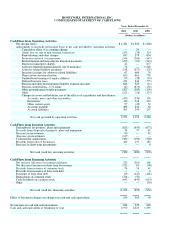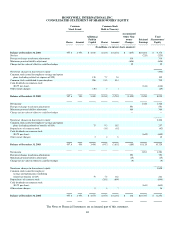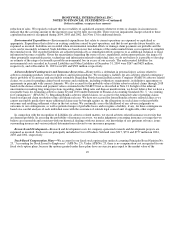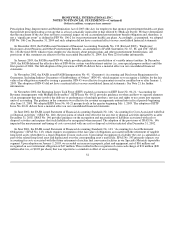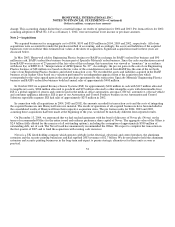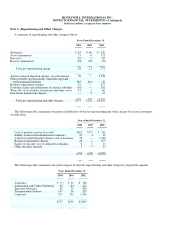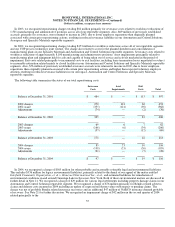Honeywell 2004 Annual Report Download - page 70
Download and view the complete annual report
Please find page 70 of the 2004 Honeywell annual report below. You can navigate through the pages in the report by either clicking on the pages listed below, or by using the keyword search tool below to find specific information within the annual report.
HONEYWELL INTERNATIONAL INC.
NOTES TO FINANCIAL STATEMENTS—(Continued)
(Dollars in millions, except per share amounts)
hedged items are recorded in current earnings. For derivatives designated as cash flow hedges, the effective portion of the changes in
fair value of the derivatives are recorded in Accumulated Other Nonowner Changes and subsequently recognized in earnings when the
hedged items impact earnings. Changes in the fair value of derivatives not designated as hedges and the ineffective portion of cash
flow hedges are recorded in current earnings.
Transfers of Financial Instruments—Sales, transfers and securitization of financial instruments are accounted for under
Statement of Financial Accounting Standards No. 140, “Accounting for Transfers and Servicing of Financial Assets and
Extinguishments of Liabilities”. We sell interests in designated pools of trade accounts receivables to third parties. The receivables are
removed from the Consolidated Balance Sheet at the time they are sold. The value assigned to our subordinated interests and
undivided interests retained in trade receivables sold is based on the relative fair values of the interests retained and sold. The carrying
value of the retained interests approximates fair value due to the short-term nature of the collection period for the receivables.
Income Taxes—Deferred tax liabilities or assets reflect temporary differences between amounts of assets and liabilities for
financial and tax reporting. Such amounts are adjusted, as appropriate, to reflect changes in tax rates expected to be in effect when the
temporary differences reverse. A valuation allowance is established to offset any deferred tax assets if, based upon the available
evidence, it is more likely than not that some or all of the deferred tax assets will not be realized.
Earnings Per Share—Basic earnings per share is based on the weighted average number of common shares outstanding. Diluted
earnings per share is based on the weighted average number of common shares outstanding and all dilutive potential common shares
outstanding.
Use of Estimates—The preparation of consolidated financial statements in conformity with generally accepted accounting
principles requires management to make estimates and assumptions that affect the reported amounts in the financial statements and
related disclosures in the accompanying notes. Actual results could differ from those estimates. Estimates and assumptions are
periodically reviewed and the effects of revisions are reflected in the consolidated financial statements in the period they are
determined to be necessary.
Reclassifications—Certain prior year amounts have been reclassified to conform with the current year presentation.
Recent Accounting Pronouncements—In December 2004, the FASB issued Statement of Financial Accounting Standards No.
123 (revised), “Share-Based Payment (Revised 2004)” (SFAS 123R) requiring that the compensation cost relating to share-based
payment transactions be recognized in financial statements. The cost is to be measured based on the fair value of the equity or liability
instruments issued. SFAS 123R is effective as of the first interim or annual reporting period beginning after June 15, 2005. We
currently expect that the adoption of SFAS 123R will reduce 2005 diluted earnings per share by $0.04 to $0.05.
In November 2004, the FASB issued Statement of Financial Accounting Standards No. 151, “Inventory Costs, an amendment of
ARB No. 43, Chapter 4” (SFAS No. 151) which amends Accounting Research Bulletin (ARB) No. 43, Chapter 4, to clarify that
abnormal amounts of idle facility expense, freight, handling costs and wasted materials (spoilage) should be recognized as current-
period charges. In addition, SFAS No. 151 requires that allocation of fixed production overhead to inventory be based on the normal
capacity of the production facilities. SFAS No. 151 is effective for inventory costs incurred during fiscal years beginning after
June 15, 2005. We are currently assessing the impact of SFAS No. 151 on our consolidated financial statements.
In May 2004, the FASB issued FASB Staff Position No. 106-2, “Accounting and Disclosure Requirements Related to the
Medicare Prescription Drug, Improvement and Modernization Act of 2003” (FSP No. 106-2) which provides guidance on accounting
for the effects of the Medicare
51



